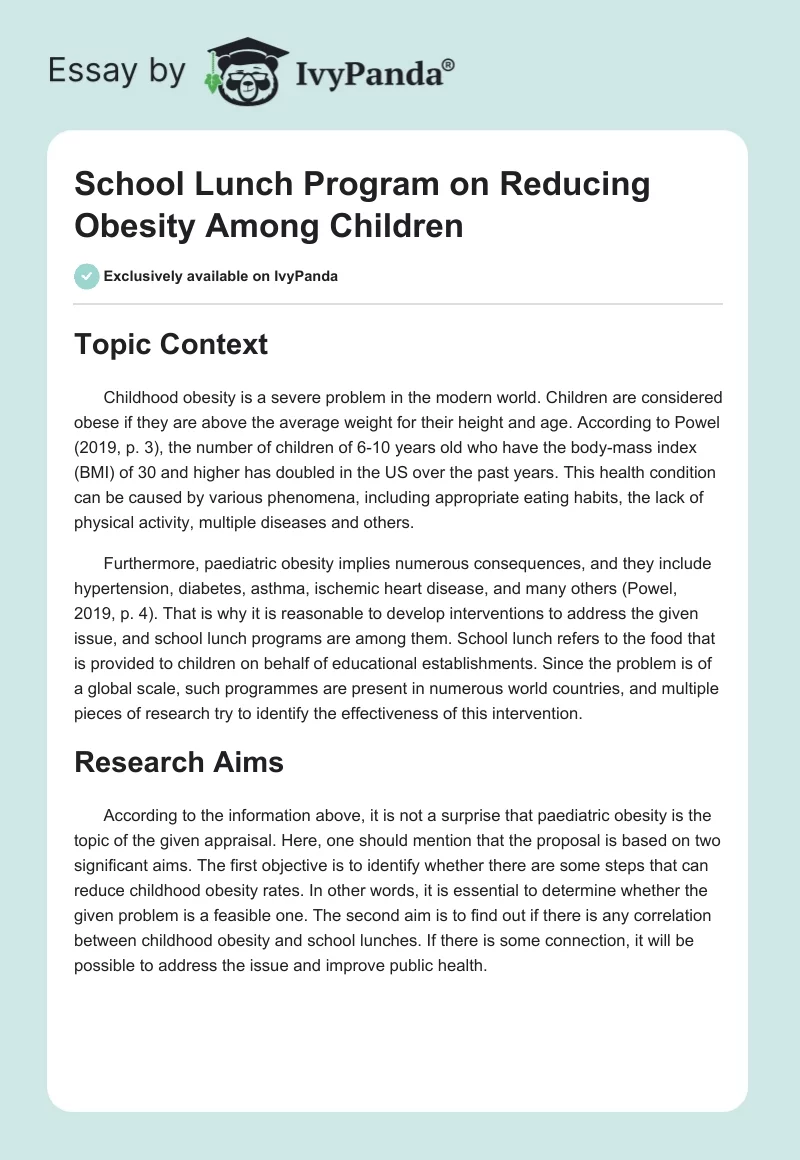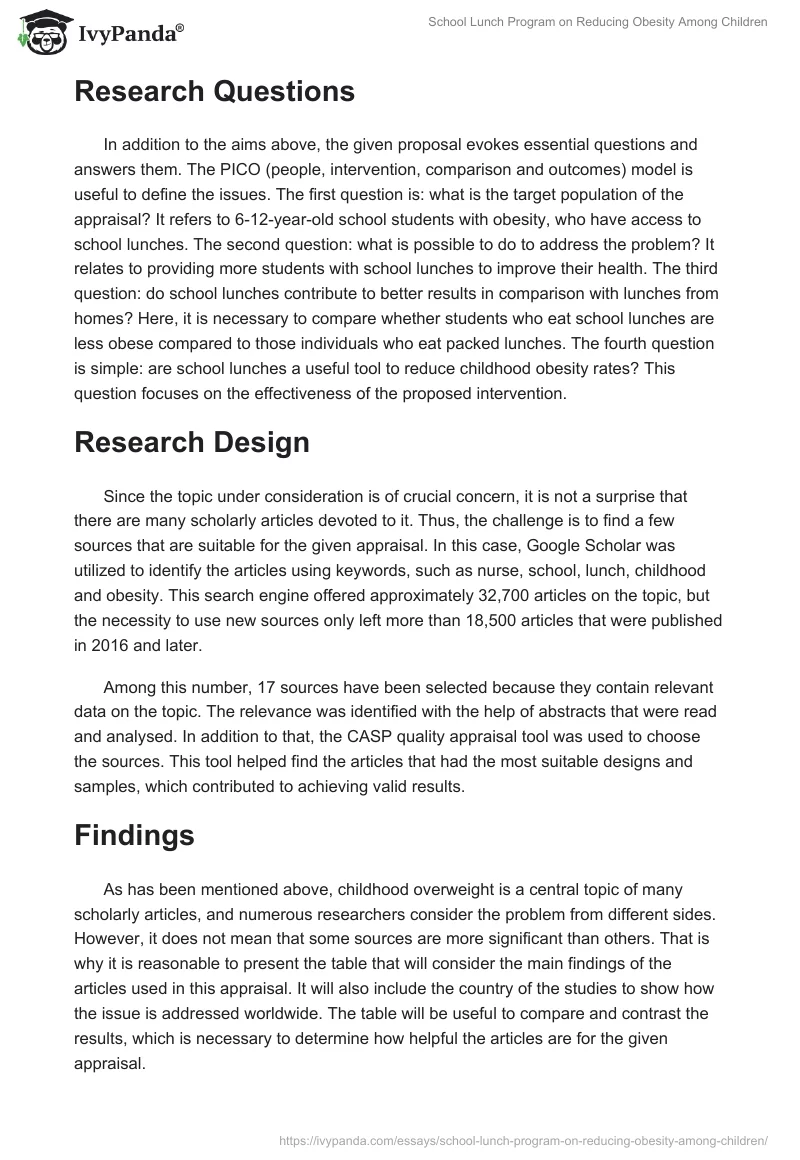Topic Context
Childhood obesity is a severe problem in the modern world. Children are considered obese if they are above the average weight for their height and age. According to Powel (2019, p. 3), the number of children of 6-10 years old who have the body-mass index (BMI) of 30 and higher has doubled in the US over the past years. This health condition can be caused by various phenomena, including appropriate eating habits, the lack of physical activity, multiple diseases and others.
Furthermore, paediatric obesity implies numerous consequences, and they include hypertension, diabetes, asthma, ischemic heart disease, and many others (Powel, 2019, p. 4). That is why it is reasonable to develop interventions to address the given issue, and school lunch programs are among them. School lunch refers to the food that is provided to children on behalf of educational establishments. Since the problem is of a global scale, such programmes are present in numerous world countries, and multiple pieces of research try to identify the effectiveness of this intervention.
Research Aims
According to the information above, it is not a surprise that paediatric obesity is the topic of the given appraisal. Here, one should mention that the proposal is based on two significant aims. The first objective is to identify whether there are some steps that can reduce childhood obesity rates. In other words, it is essential to determine whether the given problem is a feasible one. The second aim is to find out if there is any correlation between childhood obesity and school lunches. If there is some connection, it will be possible to address the issue and improve public health.
Research Questions
In addition to the aims above, the given proposal evokes essential questions and answers them. The PICO (people, intervention, comparison and outcomes) model is useful to define the issues. The first question is: what is the target population of the appraisal? It refers to 6-12-year-old school students with obesity, who have access to school lunches. The second question: what is possible to do to address the problem? It relates to providing more students with school lunches to improve their health. The third question: do school lunches contribute to better results in comparison with lunches from homes? Here, it is necessary to compare whether students who eat school lunches are less obese compared to those individuals who eat packed lunches. The fourth question is simple: are school lunches a useful tool to reduce childhood obesity rates? This question focuses on the effectiveness of the proposed intervention.
Research Design
Since the topic under consideration is of crucial concern, it is not a surprise that there are many scholarly articles devoted to it. Thus, the challenge is to find a few sources that are suitable for the given appraisal. In this case, Google Scholar was utilized to identify the articles using keywords, such as nurse, school, lunch, childhood and obesity. This search engine offered approximately 32,700 articles on the topic, but the necessity to use new sources only left more than 18,500 articles that were published in 2016 and later.
Among this number, 17 sources have been selected because they contain relevant data on the topic. The relevance was identified with the help of abstracts that were read and analysed. In addition to that, the CASP quality appraisal tool was used to choose the sources. This tool helped find the articles that had the most suitable designs and samples, which contributed to achieving valid results.
Findings
As has been mentioned above, childhood overweight is a central topic of many scholarly articles, and numerous researchers consider the problem from different sides. However, it does not mean that some sources are more significant than others. That is why it is reasonable to present the table that will consider the main findings of the articles used in this appraisal. It will also include the country of the studies to show how the issue is addressed worldwide. The table will be useful to compare and contrast the results, which is necessary to determine how helpful the articles are for the given appraisal.
Discussions
According to the table above, the sources are suitable for the appraisal because they address its aims and research questions. On the one hand, one should draw attention to the objectives. Thus, it has been indicated that childhood obesity is a severe problem that, however, can be solved. For example, the study by Miyawaki, Lee and Kobayashi (2019, p. 362) proves that overweight can be addressed with the help of a healthy diet. Furthermore, a few sources support the idea that there is a close connection between reducing childhood obesity and school lunches. It is so because these meals provide students with the necessary nutrients. Thus, Vernarelli and O’Brien (2017, p. 1) stipulate that school lunches are healthier because they contain less sugar and fat.
On the other hand, multiple articles provide data that are necessary to answer the research questions. Firstly, Morshed et al. (2016, p. 3378) indicate that the target population is children of 3-13 years old. Secondly, Evans et al. (2016, p. 36) show that it is necessary to provide more children with school lunches because these meals provide the students with essential nutrients. Thirdly, some researchers try to identify the effectiveness of the given proposal by comparing the results of the children who eat school lunches and those who eat lunches from their homes.
Minaya and Rainville (2016, p. 6) have demonstrated the effectiveness of school lunches because they do not have ingredients that can contribute to childhood obesity. Finally, numerous articles show that school lunches are useful, but their effectiveness depends on external factors. Thus, Harrell (2017, p. 198) indicates that children need sufficient time to benefit from school lunches, while Hildebrand, Betts and Gates (2019) focus on the fact that parents’ participation is required to address childhood obesity. Consequently, the studies under consideration are useful for the given appraisal.
Reference List
Asirvatham, J. et al. (2019) ‘Do fast food restaurants surrounding schools affect childhood obesity?’ Economics & Human Biology, 33, pp. 124-133.
Bramante, C.T. et al. (2019) ‘Systematic review of natural experiments for childhood obesity prevention and control’, American Journal of Preventive Medicine, 56(1), pp. 147-158.
Evans, C.E. et al. (2016) ‘Impact of school lunch time on nutritional quality of English children’s diets’, Public Health Nutrition, 19(1), pp. 36-45.
Greece, J.A. et al. (2017) ‘Effects of a school-based intervention on middle school children’s daily food and beverage intake’, Health Behaviour and Policy Review, 4(1), pp. 24-36.
Harrell, H. (2017) ‘Children need sufficient time to eat school lunch’, American Journal of Public Health, 107(2), p. 198.
Hildebrand, D.A., Betts, N.M. and Gates, G.E. (2019) ‘Parents’ perceptions of childhood obesity and support of the school wellness policy’, Journal of Nutrition Education and Behaviour, 51(4), pp. 498-504.
Kenney, E.L. et al. (2019) ‘Cost-effectiveness of water promotion strategies in schools for preventing childhood obesity and increasing water intake’, Obesity Society, 27(12), pp. 2037-2045.
McLoughlin, G. et al. (2017) ‘School lunch and physical activity during recess: interactive effects of health behaviours in the school setting’, The FASEB Journal, 31(1), p. 4866.
Minaya, S. and Rainville, A.J. (2016) ‘How nutritious are children’s packed school lunches? A comparison of lunches brought from home and school lunches’, The Journal of Child Nutrition & Management, 40(2), pp. 1-7.
Miyawaki, A., Lee, J.S. and Kobayashi, Y. (2019) ‘Impact of the school lunch programme on overweight and obesity among junior high school students: a nationwide study in Japan’, Journal of Public Health, 41(2), pp. 362-370.
Morshed, A.B. et al. (2016) ‘Early nutrition transition in Haiti: linking food purchasing and availability to overweight status in school-aged children’, Public Health Nutrition, 19(18), pp. 3378-3385.
Olarte, D.A. et al. (2019) ‘P129 How ‘teachers’ childhood school lunch experiences impact their views and actions related to school lunch with their students’, Journal of Nutrition Education and Behaviour, 51(7), pp. S90-S91.
Powel, F. (2019) ‘Childhood obesity: getting back to the basics’, DNP Qualifying Manuscripts, pp. 1-15.
Vernarelli, J.A. (2017) ‘The case for school lunch: comparison of diet quality among National Lunch Programme participants vs. income-eligible non-participants’, The FASEB Journal, 31(1). Web.
Vernarelli, J.A. and O’Brien, B. (2017) ‘A vote for school lunches: school lunches provide superior nutrient quality than lunches obtained from other sources in a nationally representative sample of US children’, Nutrients, 9(9), pp. 1-10.
Wang, Y. et al. (2017) ‘Child and parental perspectives on diet and physical activity decisions: implications for childhood obesity prevention in China’, Asia Pacific Journal of Clinical Nutrition, 26(5), pp. 888-898.
Welker, E., Lott, M. and Story, M. (2016) ‘The school food environment and obesity prevention: progress over the last decade’, Current Obesity Reports, 5, pp. 145-155.


